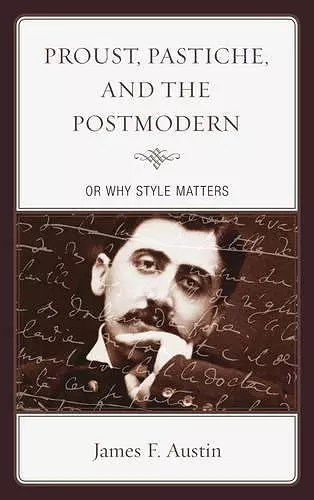Proust, Pastiche, and the Postmodern or Why Style Matters
Format:Paperback
Publisher:Bucknell University Press
Published:17th Apr '15
Currently unavailable, and unfortunately no date known when it will be back
This paperback is available in another edition too:
- Hardback£87.00(9781611484106)

Proust, Pastiche, and the Postmodern, or Why Style Matters argues against the traditional view that Marcel Proust wrote pastiches, that is, texts that imitate the style of another author, to master his literary predecessors while sharpening his writerly quill. On the contrary, James F. Austin demonstrates that Proust’s oeuvre, and In Search of Lost Time in particular, deploy pastiche to other ends: Proust’s pastiches, in fact, “do things with words” to create powerful real-world effects. His works are indeed performative acts that forge social relationships, redefine our ideas of literature, and even work against oppressive political and economic discourses. Building on the “speech-act” theory of J.L. Austin, Jacques Derrida, and J. Hillis Miller, and on the postmodern theory of Fredric Jameson, this book not only elucidates the performative nature of pastiche, but also shows that the famous “Goncourt” pastiche from In Search of Lost Time has attracted so much attention because it already attained the postmodern; that is, it eliminated temporal depth and experience, transforming time itself into a nostalgic style of an era, and into the sort of aestheticized surface that came to define postmodernism decades later. To reflect this transformation of pastiche, this work rearticulates its history in France around Proust. Reconfiguring a scholastic, classically-inspired pedagogical tradition based on imitation, and breaking with the dominant satirical practice, Proust’s work opened up possibilities in the twentieth century for a new kind of pastiche: playful and performative in the literary field, and postmodern in a French cinema that, as with the Goncourt pastiche, represents time as the visual style of an era, whether unreflexively in “heritage” films such as Régis Wargnier’s Indochine, or discerningly in Eric Rohmer’s Lady and the Duke, which uses period pictorial and painterly conventions to illustrate how the representation of history onscreen typically flattens time into style.
Austin's repeated claim to work under the banner of his poststructuralist mentors should not discourage readers. Austin (Connecticut College) writes well and clearly about his subject. He has carefully read the relevant Proust criticism, basing his analyses appropriately on Jean Milly, though he is regrettably negligent in regard to larger theory on related, intertextual devices like allusion. Contrary to Austin's claim, he has not revised the history of pastiche. The device has long been performative and parodic. Still, his fine analysis of Proust's treatment offers an original view through the lens of pastiche. Although this side of Proust is most often associated with Pastiches et mélanges, it is also and perhaps especially a major element in À la recherche du temps perdu, where it allowed him to engage Homer, the Goncourts, and, more interestingly, his own characters and, indeed, himself. Proust was a stylistic master, able to integrate his pastiches seamlessly into his masterpiece. Austin also considers pastiche in subsequent writers like Maurois, Martin-Chauffier, Modiano, and Perec in some detail. He finally considers pastiche in major directors like Godard, Rohmer, and Agnès Varda. Summing Up: Recommended. Researchers, faculty. * CHOICE *
ISBN: 9781611486926
Dimensions: 226mm x 154mm x 18mm
Weight: 376g
250 pages